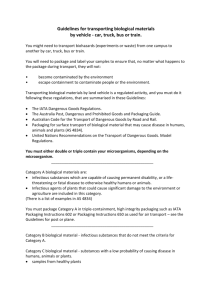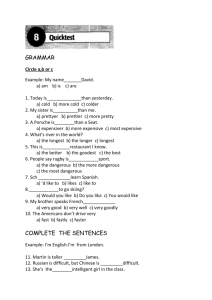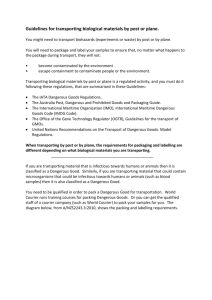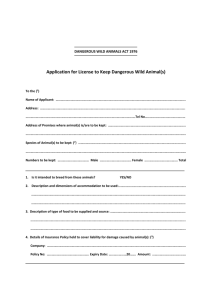Safety adviser competences
advertisement
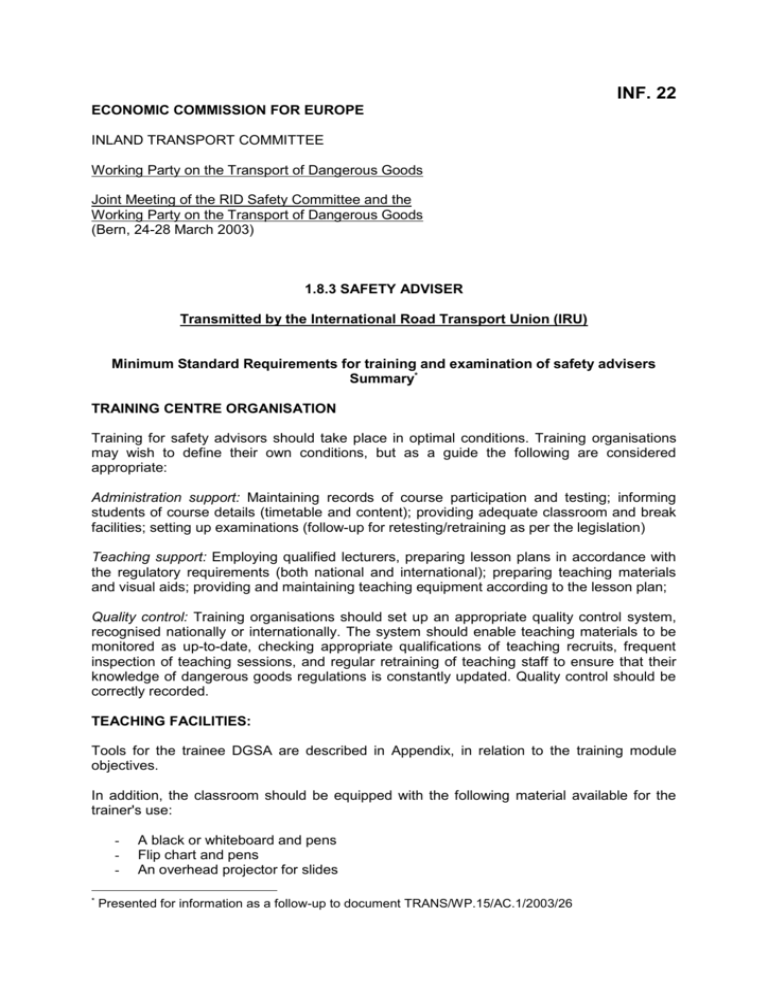
INF. 22 ECONOMIC COMMISSION FOR EUROPE INLAND TRANSPORT COMMITTEE Working Party on the Transport of Dangerous Goods Joint Meeting of the RID Safety Committee and the Working Party on the Transport of Dangerous Goods (Bern, 24-28 March 2003) 1.8.3 SAFETY ADVISER Transmitted by the International Road Transport Union (IRU) Minimum Standard Requirements for training and examination of safety advisers Summary* TRAINING CENTRE ORGANISATION Training for safety advisors should take place in optimal conditions. Training organisations may wish to define their own conditions, but as a guide the following are considered appropriate: Administration support: Maintaining records of course participation and testing; informing students of course details (timetable and content); providing adequate classroom and break facilities; setting up examinations (follow-up for retesting/retraining as per the legislation) Teaching support: Employing qualified lecturers, preparing lesson plans in accordance with the regulatory requirements (both national and international); preparing teaching materials and visual aids; providing and maintaining teaching equipment according to the lesson plan; Quality control: Training organisations should set up an appropriate quality control system, recognised nationally or internationally. The system should enable teaching materials to be monitored as up-to-date, checking appropriate qualifications of teaching recruits, frequent inspection of teaching sessions, and regular retraining of teaching staff to ensure that their knowledge of dangerous goods regulations is constantly updated. Quality control should be correctly recorded. TEACHING FACILITIES: Tools for the trainee DGSA are described in Appendix, in relation to the training module objectives. In addition, the classroom should be equipped with the following material available for the trainer's use: * A black or whiteboard and pens Flip chart and pens An overhead projector for slides Presented for information as a follow-up to document TRANS/WP.15/AC.1/2003/26 - A computer with overhead projection facility Video projector and television A copy of the ADR regulations National regulations pertaining to the transport of dangerous goods by road UN approved drum Hazard diamonds Sample transport documents Sample dangerous goods notes. QUALIFICATION OF TRAINERS Trainers should have comprehensive knowledge of national and international dangerous goods legislation. They should have practical experience of training and of the transport of all types of dangerous goods. They should be able to demonstrate an efficient and appropriate teaching approach in the classroom and be familiar with pedagogical techniques. SAFETY ADVISER COMPETENCES Field of activity MONITORING Knowledge (tasks or duties of the advisor based on Annex I of EC Directive 96/35/EC) Ensure that the undertaking advised complies with the regulations for the transport of dangerous goods, in particular: Observance of the rules governing the classification and identification of the dangerous goods Checking the adequacy between goods and the type of vehicle used to transport those goods Checking the adequacy between goods and the type of containment systems Checking the equipment used in connection with the transport, loading and unloading of dangerous goods Checking that all personnel involved in transport, loading or unloading of dangerous goods have detailed operational procedures and instructions and are aware of the risks during these operations Ensuring employees have proper training (which is up-to-date) according to their responsibilities and records are kept Ensuring that procedures dealing with incidents or accidents involving dangerous goods are in place Ensuring sub-contractors comply with necessary legal requirements Ensuring procedures exist to check the presence of documents and safety equipment on board the vehicle Learning objectives (competence as defined in Annex II of EC Directive 96/35/EC) Classify dangerous goods, according to: The procedure for classifying solutions and mixtures The structure of the description of substances The classes of dangerous goods and the principles of their classification The nature of the dangerous substances and articles transported Their physical, chemical and toxicological properties Observe safety procedures relative to the method of consignment and restrictions on dispatch: Full load Bulk transport Transport in large bulk containers Container transport Transport in fixed and removable tanks Take into account prohibitions and precautions relating to mixed loading Observe correct segregation of substances Observe limits on the quantities carried and quantities exempt Observe that regulations concerning cleaning and/or degassing before loading and after unloading are applied Recognise general packaging requirements, to include tankers, tankcontainers etc: Types of packaging, codification and marking Packaging requirements and prescriptions for testing packaging The state of packaging and periodic checks Field of activity MONITORING (cont') Knowledge (tasks or duties of the advisor based on Annex I of EC Directive 96/35/EC) Learning objectives (competence as defined in Annex II of EC Directive 96/35/EC) Recognise danger markings and labels: The markings on danger labels The placing of danger labels Placarding and labelling Recognise requirements relating to transport equipment Apply correct handling and stowage procedures: Loading and unloading (filling ratios) Stowage and segregation Recognise references in transport documents: Information in the transport document The consignor's declaration of conformity Apply surveillance obligations: parking Observe traffic regulations and restrictions Make arrangements for the vocational training of crews Take general preventive and safety measures, with particular regard to : Typical consequences of accidents involving dangerous goods Main causes of accidents Recognise the risks of operational and accidental discharges of pollutants Implement safety instructions and ensure correct use of driver protection equipment Recognise the documents to be kept aboard the vehicle: The transport document Written instructions The vehicle-approval certificate The vehicle driver's training certificate Copies of any derogations Other documents APPENDIX: TRAINING MODULES AND TEACHING UNITS Training module objective Classify dangerous goods according to: The classes of dangerous goods and the principles of their classification Their physical, chemical and toxicological properties The nature of the dangerous substances and articles transported The structure of the description of substances The procedure for classifying solutions and mixtures Teaching units (hours) 5 Identify general packaging requirements, to include tankers, tankcontainers according to: Types of packaging, codification and marking Packaging requirements and prescriptions for testing packaging The state of packaging and periodic checks Identify danger markings and labels, including: o The markings on danger labels o The placing of danger labels o Placarding and labelling 3 Identify in transport documents: Information in the transport document 2 The consignor's declaration of conformity Identify in vehicle papers The transport document Written instructions The vehicle-approval certificate The vehicle driver's training certificate Copies of any derogations Other documents Identify the limits on quantities carried and quantities exempt Apply general preventative and safety measures, according to: Types of consequences which may be caused by an accident involving dangerous goods Main causes of accidents Identify and apply general preventative and safety measures concerning operational and accidental discharges of pollutants Recognise role of vocational training of crews Appendix – Training modules and training targets for Dangerous Goods Safety Advisor 1 1 2 CHEMICAL CLASSES (Classes 3, 4.1, 4.2,4.3, 5.1, 5.2, 6.1, 6.2, 8 and 9) Training module objective Classify dangerous goods according to: The classes of dangerous goods and the principles of their classification Their physical, chemical and toxicological properties The nature of the dangerous substances and articles transported Identify general packaging requirements, to include tankers, tank-containers etc: Types of packaging, codification and marking Packaging requirements and prescriptions for testing packaging Identify danger markings and labels: The markings on danger labels The placing of danger labels Placarding and labelling Refer to information in the transport documents: Teaching units (hours) 2 Identify limits on the quantities carried and quantities exempt Identify procedure in the case of operational and accidental discharges of pollutants Recognise vocational training needs for crews Appendix – Training modules and training targets for Dangerous Goods Safety Advisor 2 1 1 1 1 CLASS 7 Training module objective Classify dangerous goods according to: The classes of dangerous goods and the principles of their classification The nature of the dangerous substances and articles transported Their physical, chemical and toxicological properties Identify general packaging requirements, to include tankers, tank-containers etc: Types of packaging, codification and marking Packaging requirements and prescriptions for testing packaging Identify danger markings and labels: The markings on danger labels The placing of danger labels Placarding and labelling Refer to information in the transport documents: Recognise the consignor's declaration of conformity Identify limits on quantities carried and quantities exempt Recognise need for the segregation of substances Identify prohibitions and precautions relating to mixed loading Recognise correct handling and stowage procedures: Loading and unloading Stowage and segregation Recognise obligations linked to surveillance and parking Identify traffic regulations and restrictions Identify regulations concerning transport of passengers Implement safety instructions and identify driver protection equipment identify procedures in case of operational and accidental discharges of pollutants Identify vocational training needs of crews Teaching units (hours) 1 2 1 1 1 1 1 1 Notes: 1. The column for specific tools shows the tools, which are specifically linked to that particular performance objective. A list of general training aids follows this section. 2. The column for teaching time is the recommended minimum teaching time. More time may be necessary depending on the nature of the national legislation relating to dangerous goods. Appendix – Training modules and training targets for Dangerous Goods Safety Advisor ROAD Training module objective Teaching units (hours) 2 Recognise transport Units Identify marking, labelling and placarding requirements 1 Identify required documentation 1 Identify compliance thresholds 1 Identify correct procedures for filling, stowage, loading and segregation 2 Identify procedures for cleaning and/or decontamination 1 Identify operational procedures 1 Recognise emergency response requirements 1 Recognise general environmental protection measures to be taken 1 Identify training needs Recognise legal framework of dangerous goods transport 1 1 ALL CLASSES (Classes 1-9) Training module objective Classify dangerous goods according to: The classes of dangerous goods and the principles of their classification Their physical, chemical and toxicological properties The nature of the dangerous substances and articles transported Recognise general packaging requirements, to include tankers, tankcontainers etc: Types of packaging, codification and marking Packaging requirements and prescriptions for testing packaging Identify danger markings and labels: The markings on danger labels The placing of danger labels Placarding and labelling Refer to information in transport documents: Identify limits on the quantities carried and quantities exempt Identify procedures in the case of operational and accidental discharges of pollutants Identify the vocational training needs of crews Appendix – Training modules and training targets for Dangerous Goods Safety Advisor Teaching units (hours) 2 2 1 1 1 1 CLASS 1 Training module objective Situate the transport of dangerous goods within the general economic and legislative environment Classify dangerous goods Recognise packaging requirements Identify marking, labelling and placarding requirements Identify requirements for documentation Recognise filling, storage, loading and segregation obligations Identify operational requirements Identify procedures to be observed in case of incident or accident Teaching units (hours) 1 2 1 1 1 1 1 2 CLASS 2 Training module objective Situate the transport of dangerous goods within the general economic and legislative environment Classify dangerous goods Recognise containment systems Identify packaging specific to Class 2 Identify marking, labelling and placarding requirements Identify requirements for documentation Recognise filling, storage, loading and segregation obligations Identify operational requirements Identify procedures to be observed in case of incident Teaching units(hours) 1 2 2 1 1 1 2 1 1 PETROL Training module objective Situate the transport of dangerous goods within the general economic and legislative environment Classify dangerous goods Recognise packaging requirements Identify marking, labelling and placarding requirements Identify requirements for documentation Recognise filling, storage, loading, and segregation obligations Identify operational requirements Identify procedures to be observed in case of incident Teaching units (hours) 1 Appendix – Training modules and training targets for Dangerous Goods Safety Advisor 2 1 1 1 2 2 1 EXAMINATION Compulsory testing for safety advisors is through multiple choice questions, short open questions and case study questions. Regular retesting of safety advisors enables them to monitor and to maintain their competences and to check that knowledge of regulatory modifications linked to their activity is up-to-date. It is recommended that the pass rate for the DGSA exam should be of 60 % for each exam. Examination facilities Standard requirements for authorised examination facilities for DGSA Centres must be approved by the competent authority or their nominated examination body Centres must nominate a contact to the competent authority or their nominated examination body. All material relating to the examinations will be sent to the contact The contact must be available on examination days in case a message needs to be delivered to the examination room The examination centre must have a room or rooms which is/are suitable for hosting the examination based on the estimated number of applicants The examination centre must have an adequate number of tables (of suitable size) and chairs for the number of applicants The competent authority or their approved examination body will appoint and pay all invigilators Examination day procedures Only the following personnel are allowed into the examination room during the examination: Candidates enrolled for the examination Invigilators of the examination The centre contact Competent authority or their examination body personnel Centre staff in the event of an emergency Candidates identity must be checked on entering the examination room e.g. passport, driving licence etc. No noise of other disturbances are allowed in the vicinity of the examination room or rooms The tables and chairs must be laid out to allow the candidate to use the permitted examination material. No communication between candidates is allowed The tables and chairs must be laid out to minimise the possibility of candidates communicating Only the permitted texts are allowed to be used by the candidates during the examination Mobile telephones and electronic equipment are not allowed in the examination room Any information being displayed in the room which could be of assistance to candidates must be removed prior to the start of the examination QUESTION BANK Appendix – Training modules and training targets for Dangerous Goods Safety Advisor A question bank is provided for examiners and contains multiple choice questions, short answer questions and case studies. Questions: These questions have been categorised according to the class of dangerous goods (Explosives, radioactive etc). The examiner should select amongst the questions proposed an appropriate number of questions and a defined time. However, twenty direct answer questions or forty multiple choice questions in two and a half hours would constitute a suitable combination, In addition to these multiple-choice and/or short questions, the examination must contain one or more case study(ies). Case studies: The case studies have been categorised according to the class of dangerous goods. Different case studies are provided for one class of product and different examination times are provided to offer the examiner a choice of combination: if the multiple choice questions are more heavily weighted, more time will be given to this part of the examination and if the case study is deemed more important, a longer case study will be selected (or several short ones) and fewer multiple choice questions used. However, a suitable combination would be a session of one hour and a half on one or several case studies. FINAL REMARKS The training and examination standards will be brought up to date at least every 2 years corresponding to modifications of ADR/RID/AND. ------------------- Appendix – Training modules and training targets for Dangerous Goods Safety Advisor
